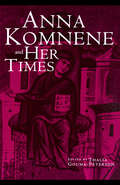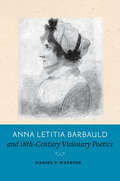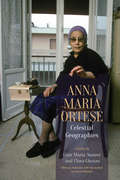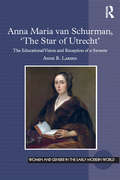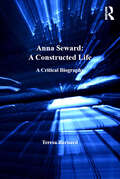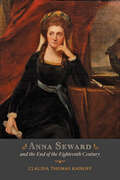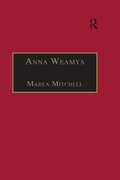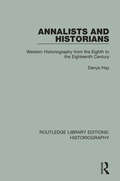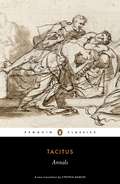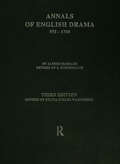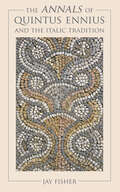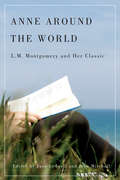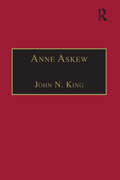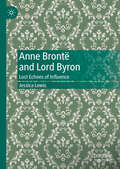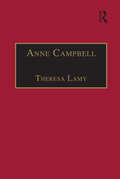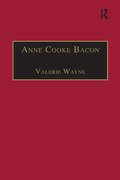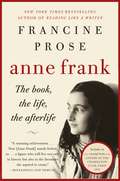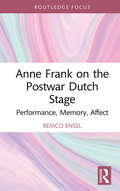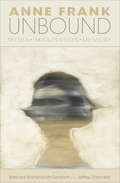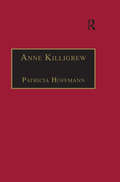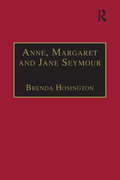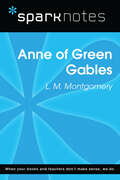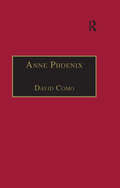- Table View
- List View
Anna Komnene and Her Times (Garland Medieval Casebooks #Vol. 29)
by Thalia Gouma-PetersonThis significant critical anthology explores the life of Anna Komnene, the Byzantine context in which she wrote, and the impact of the Alexiad on her times and on subsequent historical works of literature.
Anna Letitia Barbauld and Eighteenth-Century Visionary Poetics
by Daniel P. WatkinsIn this first critical study of Anna Letitia Barbauld’s major work, Daniel P. Watkins reveals the singular purpose of Barbauld’s visionary poems: to recreate the world based on the values of liberty and justice. Watkins examines in close detail both the form and content of Barbauld’s Poems, originally published in 1773 and revised and reissued in 1792. Along with careful readings of the poems that situate the works in their broader political, historical, and philosophical contexts, Watkins explores the relevance of the introductory epigraphs and the importance of the poems’ placement throughout the volume. Centering his study on Barbauld’s effort to develop a visionary poetic stance, Watkins argues that the deliberate arrangement of the poems creates a coherent portrayal of Barbauld’s poetic, political, and social vision, a far-sighted sagacity born of her deep belief that the principles of love, sympathy, liberty, and pacifism are necessary for a secure and meaningful human reality. In tracing the contours of this effort, Watkins examines, in particular, the tension in Barbauld’s poetry between her desire to engage directly with the political realities of the world and her equally strong longing for a pastoral world of peace and prosperity. Scholars of British literature and women writers will welcome this important study of one of the eighteenth century’s foremost writers.
Anna Maria Ortese
by Gian Maria Annovi Flora GhezzoAfter years of obscurity, Anna Maria Ortese (1914-1998) is emerging as one of the most important Italian authors of the twentieth-century, taking her place alongside such luminaries as Italo Calvino, Primo Levi, and Elsa Morante. Anna Maria Ortese: Celestial Geographies features a selection of essays by established Ortese scholars that trace her remarkable creative trajectory.Bringing a wide range of critical perspectives to Ortese's work, the contributors to this collection map the author's complex textual geography, with its overlapping literary genres, forms, and conceptual categories, and the rhetorical and narrative strategies that pervade Ortese's many types of writing. The essays are complemented by material translated here for the first time: Ortese's unpublished letters to her mentor, the writer Massimo Bontempelli; and an extended interview with Ortese by fellow Italian novelist Dacia Maraini.
Anna Maria van Schurman, 'The Star of Utrecht': The Educational Vision and Reception of a Savante (Women and Gender in the Early Modern World)
by Anne R. LarsenDutch Golden Age scholar Anna Maria van Schurman was widely regarded throughout the seventeenth century as the most learned woman of her age. She was 'The Star of Utrecht','The Dutch Minerva','The Tenth Muse', 'a miracle of her sex', 'the incomparable Virgin', and 'the oracle of Utrecht'. As the first woman ever to attend a university, she was also the first to advocate, boldly, that women should be admitted into universities. A brilliant linguist, she mastered some fifteen languages. She was the first Dutch woman to seek publication of her correspondence. Her letters in several languages Hebrew, Greek, Latin, and French – to the intellectual men and women of her time reveal the breadth of her interests in theology, philosophy, medicine, literature, numismatics, painting, sculpture, embroidery, and instrumental music. This study addresses Van Schurman's transformative contribution to the seventeenth-century debate on women's education. It analyses, first, her educational philosophy; and, second, the transnational reception of her writings on women's education, particularly in France. Anne Larsen explores how, in advocating advanced learning for women, Van Schurman challenged the educational establishment of her day to allow women to study all the arts and the sciences. Her letters offer fascinating insights into the challenges that scholarly women faced in the early modern period when they sought to define themselves as intellectuals, writers, and thoughtful contributors to the social good.
Anna Seward: A Critical Biography
by Teresa BarnardIn her critical biography of Anna Seward (1742-1809), Teresa Barnard examines the poet's unpublished letters and manuscripts, providing a fresh perspective on Seward's life and historical milieu that restores and problematizes Seward's carefully constructed narrative of her life. Of the poet Anna Seward, it may be said with some veracity that hers was an epistolary life. What is known of Seward comes from six volumes of her letters and from juvenile letters that prefaced her books of poetry, all published posthumously. That Seward intended her correspondence to serve as her autobiography is clear, but she could not have anticipated that the letters she intended for publication would be drastically edited and censored by her literary editor, Walter Scott, and by her publisher, Archibald Constable. Stripped of their vitality and much of their significance, the published letters omit telling tales of the intricacies of the marriage market and Seward's own battles against gender inequality in the educational and workplace spheres. Seward's correspondents included Erasmus Darwin, William Hayley, Helen Maria Williams, and Robert Southey, and her letters are packed with stories and anecdotes about her friends' lives and characters, what they looked like, and how they lived. Particularly compelling is Barnard's discussion of Seward's astonishing last will and testament, a twenty-page document that summarizes her life, achievements, and self-definition as a writing woman. Barnard's biography not only challenges what is known about Seward, but provides new information about the lives and times of eighteenth-century writers.
Anna Seward and the End of the Eighteenth Century
by Claudia T. KairoffAnna Seward and her career defy easy placement into the traditional periods of British literature. Raised to emulate the great poets John Milton and Alexander Pope, maturing in the Age of Sensibility, and publishing during the early Romantic era, Seward exemplifies the eighteenth-century transition from classical to Romantic. Claudia Thomas Kairoff’s excellent critical study offers fresh readings of Anna Seward’s most important writings and firmly establishes the poet as a pivotal figure among late-century British writers. Reading Seward’s writing alongside recent scholarship on gendered conceptions of the poetic career, patriotism, provincial culture, sensibility, and the sonnet revival, Kairoff carefully reconsiders Seward’s poetry and critical prose. Written as it was in the last decades of the eighteenth century, Seward’s work does not comfortably fit into the dominant models of Enlightenment-era verse or the tropes that characterize Romantic poetry. Rather than seeing this as an obstacle for understanding Seward’s writing within a particular literary style, Kairoff argues that this allows readers to see in Seward’s works the eighteenth-century roots of Romantic-era poetry. Arguably the most prominent woman poet of her lifetime, Seward’s writings disappeared from popular and scholarly view shortly after her death. After nearly two hundred years of critical neglect, Seward is attracting renewed attention, and with this book Kairoff makes a strong and convincing case for including Anna Seward's remarkable literary achievements among the most important of the late eighteenth century.
Anna Seward and the End of the Eighteenth Century
by Claudia T. KairoffA critical study of the prominent British poet’s work.Anna Seward and her career defy easy placement into the traditional periods of British literature. Raised to emulate the great poets John Milton and Alexander Pope, maturing in the Age of Sensibility, and publishing during the early Romantic era, Seward exemplifies the eighteenth-century transition from classical to Romantic. Claudia Thomas Kairoff’s excellent critical study offers fresh readings of Anna Seward's most important writings and firmly establishes the poet as a pivotal figure among late-century British writers.Reading Seward’s writing alongside recent scholarship on gendered conceptions of the poetic career, patriotism, provincial culture, sensibility, and the sonnet revival, Kairoff carefully reconsiders Seward's poetry and critical prose. Written as it was in the last decades of the eighteenth century, Seward’s work does not comfortably fit into the dominant models of Enlightenment-era verse or the tropes that characterize Romantic poetry. Rather than seeing this as an obstacle for understanding Seward’s writing within a particular literary style, Kairoff argues that this allows readers to see in Seward's works the eighteenth-century roots of Romantic-era poetry.Arguably the most prominent woman poet of her lifetime, Seward’s writings disappeared from popular and scholarly view shortly after her death. After nearly two hundred years of critical neglect, Seward is attracting renewed attention, and with this book Kairoff makes a strong and convincing case for including Anna Seward’s remarkable literary achievements among the most important of the late eighteenth century.“Professor Kairoff achieves her goal of providing “fresh readings, in a richer context,” which will go a long way toward reestablishing Seward’s importance. The book is a significant contribution to literary scholarship and will be widely read, cited, and admired.” —Paula R. Feldman“This lucid, stimulating study will challenge traditional notions not only of Seward but also of the interstice of Romanticism and late-century women authors.” —Choice“Kairoff effectively demonstrates the quality of Seward’s work, and articulates some of the ways in which a reappraisal of Seward might enrich our understanding of both eighteenth-century and Romantic-era literary cultures, and our conception of the writing practices of both male and female authors.” —Years Work in English Studies
Anna Weamys: Printed Writings 1641–1700: Series II, Part Three, Volume 7 (The Early Modern Englishwoman: A Facsimile Library of Essential Works & Printed Writings, 1641-1700: Series II, Part Three #Vol. 7)
by Marea MitchellThe title page of the 1651 continuation of Sir Philip Sidney's Arcadia, which is made available in facsimile in this volume, designates its author as 'Mris A. W.' It is now the convention to attribute the volume to Anna Weamys. Little is known about the author; the only other information about her is suggested by the substantial number of commendatory verses which precede the text. Though details about her and the specific motivations for continuing Sidney's work remain tantalisingly absent, Anna Weamys's text is important for understanding the reception of Sidney by women readers, as well as the development of prose fiction as it evolved towards the novel. Its female heroines illustrate a real concern with how women might navigate the straits of female behaviour in a judgmental and partisan society. The Introductory Note to this volume provides some analysis of how gender, class, and historical and cultural values affect what Weamys chose to pick up from Sidney's work and what seems to be of lesser interest to her. For example, in the three stories from Sidney's Arcadia on which she focuses, Weamys brings an awareness of the difficulties of women's position to bear on narrative in a way which prefigures the novel.
Annalists and Historians: Western Historiography from the VIIIth to the XVIIIth Century (Routledge Library Editions: Historiography #17)
by Denys HayThis book, originally published in 1977, is a survey of European historiography from its origins in the historians of Greece and Rome, through the annalists and chroniclers of the middle ages, to the historians of the late eighteenth century. The author concentrates on those writers whose works fit into a specific category of writing, or who have inlfuence the course of later historical writing, though he does deal with some of the more specialist forms of medieval historiography such as the crusading writers, and chivalrous historians like Froissart. He maintains that ‘modern’ history did not develop until the 18th Century.
Annals
by TacitusA compelling new translation of Tacitus' Annals, one of the greatest accounts of ancient Rome, by Cynthia Damon.Tacitus' Annals recounts the major historical events from the years shortly before the death of Augustus to the death of Nero in AD 68. With clarity and vivid intensity Tacitus describes the reign of terror under the corrupt Tiberius, the great fire of Rome during the time of Nero and the wars, poisonings, scandals, conspiracies and murders that were part of imperial life. Despite his claim that the Annals were written objectively, Tacitus' account is sharply critical of the emperors' excesses and fearful for the future of imperial Rome, while also filled with a longing for its past glories.This new Penguin Classics edition also includes chronologies, notes, appendices, a genealogy and an introduction discussing Tacitus's life and his approach to history.
The Annals of English Drama 975-1700: An Analytical Record Of All Plays, Extant Or Lost, Chronologically Arranged And Indexed By Authors, Titles, Dramatic Companies
by Sylvia Stoler WagonheimAn analytical record of all plays, extinct or lost, chronologically arranged and indexed by authors, titles and dramatic companies.
The Annals of Quintus Ennius and the Italic Tradition
by Jay FisherA fresh look at the multicultural influences on Quintus Ennius and his epic poem, the Annals.Quintus Ennius, often considered the father of Roman poetry, is best remembered for his epic poem, the Annals, a history of Rome from Aeneas until his own lifetime. Ennius represents an important bridge between Homer’s works in Greek and Vergil’s Aeneid. Jay Fisher argues that Ennius does not simply translate Homeric models into Latin, but blends Greek poetic models with Italic diction to produce a poetic hybrid. Fisher's investigation uncovers a poem that blends foreign and familiar cultural elements in order to generate layers of meaning for his Roman audience.Fisher combines modern linguistic methodologies with traditional philology to uncover the influence of the language of Roman ritual, kinship, and military culture on the Annals. Moreover, because these customs are themselves hybrids of earlier Roman, Etruscan, and Greek cultural practices, not to mention the customs of speakers of lesser-known languages such as Oscan and Umbrian, the echoes of cultural interactions generate layers of meaning for Ennius, his ancient audience, and the modern readers of the fragments of the Annals.
Anne around the World: L.M. Montgomery and Her Classic (LIT004080)
by Jane Ledwell Jean MitchellWhat makes Anne of Green Gables an international, time-honoured classic? International audiences have described reading L.M. Montgomery's most celebrated novel as an experience in enchantment. Balancing criticism and celebration, Jane Ledwell and Jean Mitchell bring together essays that consider the sources of the wonder that Montgomery's work inspires. The popular appeal of Montgomery's classic is undeniable, but the reasons for its worldwide resonance are less obvious. From a range of perspectives, the contributors to Anne around the World focus on the numerous themes the novel raises, showcasing why it has charmed readers across the globe - from Iran to Australia, and from Sweden to Japan. Essays consider issues of class, race, and colonial history, discuss Anne's place in children's literature, her passion for writing, and the ways in which L.M. Montgomery and her red-haired protagonist are celebrated by legions of fans. Featuring contributions from many international writers, Anne around the World traces the meaning and influence of a story that spread far from its place of origin on a small Canadian island to distant and culturally diverse places. Contributors include Yoshiko Akamatsu (Notre Dame Seishin University, Japan), Doreley Carolina Coll (University of Prince Edward Island), Brooke Collins-Gearing (School of Humanities and Social Science, New South Wales), Margaret Doody (Notre Dame University), Elizabeth R. Epperly (emeritus, University of Prince Edward Island), Barbara Carman Garner (Carleton University), Caroline E. Jones (Texas State University-San Marcos), Paul Keen (Carleton University), Jane Ledwell, Jennie MacDonald (PhD, University of Denver), Susan Meyer (Wellesley College), Jean Mitchell, Mary Henley Rubio (emeritus, University of Guelph), Gholamreza Sami (Sussex University), Wendy Shilton (University of Prince Edward Island), Cynthia Sugars (University of Ottawa), Tanfer Emin Tunc (Hacettepe University, Turkey), Åsa Warnqvist (Stockholm University, Sweden), Elizabeth Hillman Waterston (emeritus, University of Guelph), and Budge Wilson (author).
Anne around the World
by Jean Mitchell Jane LedwellWhat makes Anne of Green Gables an international, time-honoured classic? International audiences have described reading L.M. Montgomery's most celebrated novel as an experience in enchantment. Balancing criticism and celebration, Jane Ledwell and Jean Mitchell bring together essays that consider the sources of the wonder that Montgomery's work inspires. The popular appeal of Montgomery's classic is undeniable, but the reasons for its worldwide resonance are less obvious. From a range of perspectives, the contributors to Anne around the World focus on the numerous themes the novel raises, showcasing why it has charmed readers across the globe - from Iran to Australia, and from Sweden to Japan. Essays consider issues of class, race, and colonial history, discuss Anne's place in children's literature, her passion for writing, and the ways in which L.M. Montgomery and her red-haired protagonist are celebrated by legions of fans. Featuring contributions from many international writers, Anne around the World traces the meaning and influence of a story that spread far from its place of origin on a small Canadian island to distant and culturally diverse places. Contributors include Yoshiko Akamatsu (Notre Dame Seishin University, Japan), Doreley Carolina Coll (University of Prince Edward Island), Brooke Collins-Gearing (School of Humanities and Social Science, New South Wales), Margaret Doody (Notre Dame University), Elizabeth R. Epperly (emeritus, University of Prince Edward Island), Barbara Carman Garner (Carleton University), Caroline E. Jones (Texas State University-San Marcos), Paul Keen (Carleton University), Jane Ledwell, Jennie MacDonald (PhD, University of Denver), Susan Meyer (Wellesley College), Jean Mitchell, Mary Henley Rubio (emeritus, University of Guelph), Gholamreza Sami (Sussex University), Wendy Shilton (University of Prince Edward Island), Cynthia Sugars (University of Ottawa), Tanfer Emin Tunc (Hacettepe University, Turkey), Åsa Warnqvist (Stockholm University, Sweden), Elizabeth Hillman Waterston (emeritus, University of Guelph), and Budge Wilson (author).
Anne Askew: Printed Writings 1500–1640: Series 1, Part One, Volume 1 (The Early Modern Englishwoman: A Facsimile Library of Essential Works & Printed Writings, 1500-1640: Series I, Part One #Vol. 1)
by John N. KingAnne Askew (1521-1546) was accused of heresy because of her denial of the Catholic doctrine of transubstantiation and ritual of mass. These two works provide an extremely rare autobiographical account of heresy interrogations, torture, trial and conviction. Her manuscripts were smuggled out of England to John Bale on the Continent who edited and published them in 1545 and 1546 respectively.
Anne Brontë and Lord Byron: Lost Echoes of Influence
by Jessica LewisThis book explores the relationship between Anne Brontë’s work and the life and writings of Lord Byron. Byron’s influence on the other Brontë siblings is well-documented but absent in Anne’s history. Building on recent discourses of rich intertextuality in Anne’s work, Jessica Lewis reveals her relationship with the poet as significantly different from that of her siblings. Instead of trying to emulate Byron or derive inspiration from the concept of ‘mix’d essences’ or elemental affinity, Anne’s relationship with him is grounded in their shared Calvinistic upbringing and a rejection of its stringent principles, which propels both writers to positions of contemporary religious controversy. This volume reappraises Anne Brontë and her work in light of significant Byronic influence, and provides new readings of her novels and poetry.
Anne Campbell: Printed Writings 1500–1640: Series I, Part Four, Volume 4 (The Early Modern Englishwoman: A Facsimile Library of Essential Works & Printed Writings, 1500-1640: Series I, Part Four)
by Theresa LamyThe religious, historical and rhetorical significance of the Confessions written by St. Augustine, Bishop of Hippo, can hardly be overstated: the book is one of the unifying texts of Western Christianity and a seminal work for Roman Catholic Europe. The publication in 1622 of Duchess Anne Campbell's selections in Spanish of parts of Augustine's Confessions has been little remarked, in part at least because of the obscurity of her feat. Yet Campbell's work is worthy of attention because of the evidence it gives of one woman's education and literary interests.
Anne Cooke Bacon: Printed Writings 1500–1640: Series I, Part Two, Volume 1 (The Early Modern Englishwoman: A Facsimile Library of Essential Works & Printed Writings, 1500-1640: Series I, Part Two #Vol. 1)
by Valerie WayneAnne Cooke Bacon was highly educated and was known for her ability to read Latin, Greek, Italian and French. She married Sir Nicholas Bacon, Queen’s Keeper of the Great Seal and a member of Elizabeth’s Privy Council. The directions of the new Church of England were heavily influenced by her husband and Anne too was actively involved in the religious controversies of her day, her translations position her as a strong advocate for the Protestant cause. Whilst in her early 20s she translated the sermons of Bernardino Ochino, a popular Italian preacher who converted to Calvinism. Her translations were printed in four different volumes of Ochino’s sermons (between 1548 and 1570) although the publishers of these editions did not always see fit to name her as the translator. Translations by R. Argentyne were often included in the volumes and, in the earlier editions, he was credited with her work. The text reproduced here comes from the 1551 edition of Fouretene sermons of Barnardine Ochyne ... translated by AC as it not only includes Anne’s dedication to her mother and a preface in praise of Anne’s work but is the only edition of more than five sermons that does not also reprint translations by Argentyne. As an appendix to the present volume the five sermons translated by AC in the 1551 edition of Certayne sermons of the ryghte famous and excellent clerke ... are included. These five plus the fourteen reprinted in the body of this book constitute all of the sermons that Anne Cooke is known to have translated and published. In 1562 John Jewel’s Apologia ecclesiae anglicanae was published in England and was viewed as the authoritative defence of the English Church. Anne Cooke Bacon’s translation of it was published in 1564 and became the official English version. The text reprinted here is unusually clear and also has the advantage of including an engraving of Lady Bacon.
Anne Frank: The Book, the Life, the Afterlife
by Francine Prose“Prose’s book is a stunning achievement. . . . Now Anne Frank stands before us. . . a figure who will live not only in history but also in the literature she aspired to create.” — Minneapolis Star TribuneIn June, 1942, Anne Frank received a diary for her thirteenth birthday, just weeks before she and her family went into hiding from the Nazis in an Amsterdam attic. For two years, she described life in hiding in vivid, unforgettable detail and grappled with the unfolding events of World War II. Before the attic was raided in August, 1944, Anne Frank furiously revised and edited her work, crafting a piece of literature that she hoped would be read by the public after the war. And read it has been.In Anne Frank, bestselling author Francine Prose deftly parses the artistry, ambition, and enduring influence of Anne Frank’s beloved classic, The Diary of a Young Girl. She investigates the diary’s unique afterlife: the obstacles and criticism Otto Frank faced in publishing his daughter’s words; the controversy surrounding the diary’s Broadway and film adaptations, and the social mores of the 1950s that reduced it to a tale of adolescent angst and love; the conspiracy theories that have cried fraud, and the scientific analysis that proved them wrong. Finally, having assigned the book to her own students, Prose considers the rewards and challenges of teaching one of the world’s most read, and banned, books. How has the life and death of one girl become emblematic of the lives and deaths of so many, and why do her words continue to inspire?Approved by both the Anne Frank House Foundation in Amsterdam and the Anne Frank-Fonds in Basel, run by the Frank family, Anne Frank unravels the fascinating story of a memoir that has become one of the most compelling, intimate, and important documents of modern history.
Anne Frank on the Postwar Dutch Stage: Performance, Memory, Affect (Routledge Advances in Theatre & Performance Studies)
by Remco EnselThis book is a case study into the affective history of Holocaust drama offering a new perspective on the impact of The Diary of Anne Frank, the pivotal 1950s play that was a turning point in Holocaust consciousness. Despite its overwhelming success, criticism of the Broadway makeover has been harsh, suggesting that the alleged Americanization would not do justice to the violence of the Holocaust or Anne Frank’s budding Jewishness. This study revisits these issues by focusing on the play’s European appropriation delving into the emotional intensity with which the play was produced and received. The core of the exploration is a history of the Dutch staging in ethnographic detail, based on unique archival material such as correspondence with Otto Frank, prompt books, original tapes, blueprints of the set and oral history. The microhistory of the first Dutch performance of the stage adaptation of Anne Frank’s diary examines the staging in the context of the postwar hesitant development of publicly voiced Holocaust consciousness. Influenced by memory studies and affect theory, the emphasis is on the emotional impact of the drama on both the members of the cast and the audience and will be of great interest to students and scholars in theater and performance studies, memory studies, cultural history, Jewish studies, Holocaust studies and contemporary European history.
Anne Frank Unbound: Media, Imagination, Memory (The Modern Jewish Experience)
by Barbara Kirshenblatt-Gimblett and Jeffrey Shandler&“A brilliantly conceived and long overdue opening up [or deconstruction] of the Anne Frank story.&” —James Clifford, Professor Emeritus, History of Consciousness Department, University of California As millions of people around the world who have read her diary attest, Anne Frank, the most familiar victim of the Holocaust, has a remarkable place in contemporary memory. Anne Frank Unbound looks beyond this young girl&’s words at the numerous ways people have engaged her life and writing. Apart from officially sanctioned works and organizations, there exists a prodigious amount of cultural production, which encompasses literature, art, music, film, television, blogs, pedagogy, scholarship, religious ritual, and comedy. Created by both artists and amateurs, these responses to Anne Frank range from veneration to irreverence. Although at times they challenge conventional perceptions of her significance, these works testify to the power of Anne Frank, the writer, and Anne Frank, the cultural phenomenon, as people worldwide forge their own connections with the diary and its author. &“This collection of brilliant essays offers fascinating and unexpected insights into the significance of Anne Frank&’s iconic Holocaust-era diary from many disciplinary perspectives in the arts and humanities.&” —Jan T. Gross, the Norman B. Tomlinson Professor of War and Society, Princeton University &“This volume is a major contribution to scholarship regarding Anne Frank's diary and its cultural influence . . . Highly recommended.&” —Choice &“Engrossing . . . The overall aim is to provide a greater understanding of the general and particular engagement with Anne Frank as a person, a symbol, an icon, an inspiration, and perhaps most polarizing, as one victim, not the victim of the Nazi holocaust.&” —Broadside
Anne Killigrew: Printed Writings 1641–1700: Series II, Part Two, Volume 5 (The Early Modern Englishwoman: A Facsimile Library of Essential Works & Printed Writings, 1641-1700: Series II, Part Two #Vol. 5)
by Patricia HoffmannDuring Anne Killigrew's lifetime (1660-1685) most of her known living relatives were connected to the court, yet very little is known about Anne herself. The twenty-five complete poems and five fragments that were collected and published by her father soon after her death probably represent only a portion of her output. They are reproduced here from the copy held in the Folger Shakespeare Library. These works suggest a poet quite conversant with the period's propensity to comment and compliment in verse. They suggest a sometimes conventional, sometimes merely competent, but often quite promising writer. Moreover, unlike many of her contemporaries, Killigrew never uses Latin, or French, or Italian in her verse. From the evidence of the poems here there is good reason to think that Killigrew would have been a fine eighteenth-century poet.
Anne, Margaret and Jane Seymour: Printed Writings 1500–1640: Series I, Part Two, Volume 6 (The Early Modern Englishwoman: A Facsimile Library of Essential Works & Printed Writings, 1500-1640: Series I, Part Two)
by Brenda HosingtonDespite the fame their work brought them, and despite the importance of their parents in mid-Tudor England, relatively little is known of the lives of Anne, Margaret and Jane Seymour - daughters of Anne Stanhope and the Duke of Somerset. In 1550, aged roughly eighteen, sixteen and nine, these three noblewomen composed a Latin poem of 104 distichs on the death of Marguerite de Navarre, which they sent to their former tutor, Nicolas Denisot, now living in Paris. Entitled Annae, Margaritae, Janae, Sororum virginum heroidum anglarum, in mortem Divae Margaritae Valesiae, navarrorum Reginae, Hecatodistichon, it was the first formal and original verse encomium in Latin penned by a female author to be printed in England. The Hecatodistichon was published in Paris in 1550 by Denisot, as the cornerstone of a collective tumulus, or commemorative volume, dedicated to Marguerite. The French literati were swift to respond to the appearance of the volume. In 1551 Denisot republished the Seymour's poem in a completely new volume with a French title that emphasised the collective nature of the Tombeau volume. Both volumes are reproduced here from editions held at the British Library.
Anne of Green Gables (SparkNotes Literature Guide Series)
by SparkNotesAnne of Green Gables (SparkNotes Literature Guide) by L.M. Montgomery Making the reading experience fun! Created by Harvard students for students everywhere, SparkNotes is a new breed of study guide: smarter, better, faster. Geared to what today's students need to know, SparkNotes provides: chapter-by-chapter analysis explanations of key themes, motifs, and symbols a review quiz and essay topics Lively and accessible, these guides are perfect for late-night studying and writing papers.
Anne Phoenix: Printed Writings, 1500–1640: Series I, Part Four, Volume 5 (The Early Modern Englishwoman: A Facsimile Library of Essential Works & Printed Writings, 1500-1640: Series I, Part Four #Vol. 5)
by David ComoUnfamiliar today, The saints legacies... by Anne Fenwick (pseudonym Anne Phoenix) was a modest but unquestionable best seller. First published in 1629, it went through no fewer than thirteen editions between then and 1688. Most of the many thousands of Stuart readers would not have known that it was such a rare specimen: a work of godly practical divinity written by a woman. Anne Fenwick was a charismatic puritan, known for her zealous and radical non-conformist activities. She was arrested and tried before the Durham High Commission, after being targeted by the notoriously anti-puritan Bishop Neile, escaped from house arrest by May 1624 and became a noted author of religious writings. In 1629 one of her manuscripts, A collection of certaine promises out of the word of God, was published without her knowledge by the printer Robert Swayne, but the more definitive edition reproduced here was published by Michael Sparke in 1631. This edition was published with her consent and includes her prefatory letter, in which she explains the circumstances of the initial publication, and notes that she passed her own 'perfect copy' of the book to Swayne. It is reasonable to assume that this edition represents the version most faithful to the author's own manuscript and intentions. The knowledge that there was space for such a woman within the early Stuart puritan community - simultaneously prophetess, scriptual exegete and published writer - offers insight into the dramatic explosion of women's preaching and writing in the 1640s and 1650s.
